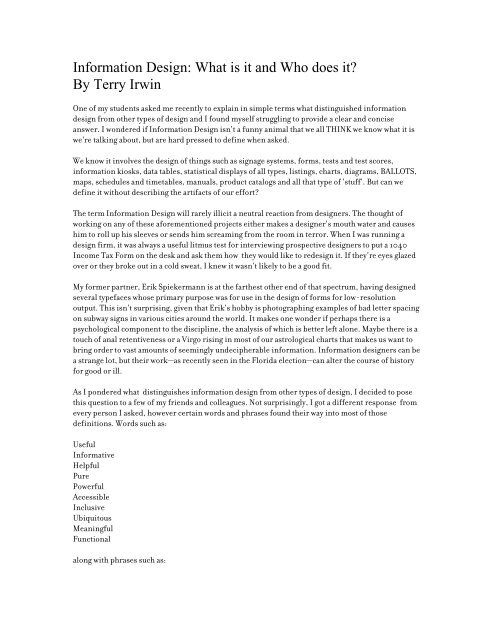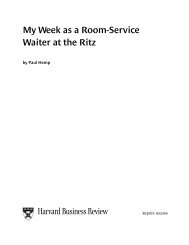Information Design: What is it and Who does it? By Terry Irwin
Information Design: What is it and Who does it? By Terry Irwin
Information Design: What is it and Who does it? By Terry Irwin
Create successful ePaper yourself
Turn your PDF publications into a flip-book with our unique Google optimized e-Paper software.
<strong>Information</strong> <strong>Design</strong>: <strong>What</strong> <strong>is</strong> <strong>it</strong> <strong>and</strong> <strong>Who</strong> <strong>does</strong> <strong>it</strong>?<strong>By</strong> <strong>Terry</strong> <strong>Irwin</strong>One of my students asked me recently to explain in simple terms what d<strong>is</strong>tingu<strong>is</strong>hed informationdesign from other types of design <strong>and</strong> I found myself struggling to provide a clear <strong>and</strong> conc<strong>is</strong>eanswer. I wondered if <strong>Information</strong> <strong>Design</strong> <strong>is</strong>n't a funny animal that we all THINK we know what <strong>it</strong> <strong>is</strong>we're talking about, but are hard pressed to define when asked.We know <strong>it</strong> involves the design of things such as signage systems, forms, tests <strong>and</strong> test scores,information kiosks, data tables, stat<strong>is</strong>tical d<strong>is</strong>plays of all types, l<strong>is</strong>tings, charts, diagrams, BALLOTS,maps, schedules <strong>and</strong> timetables, manuals, product catalogs <strong>and</strong> all that type of 'stuff'. But can wedefine <strong>it</strong> w<strong>it</strong>hout describing the artifacts of our effort?The term <strong>Information</strong> <strong>Design</strong> will rarely illic<strong>it</strong> a neutral reaction from designers. The thought ofworking on any of these aforementioned projects e<strong>it</strong>her makes a designer's mouth water <strong>and</strong> causeshim to roll up h<strong>is</strong> sleeves or sends him screaming from the room in terror. When I was running adesign firm, <strong>it</strong> was always a useful l<strong>it</strong>mus test for interviewing prospective designers to put a 1040Income Tax Form on the desk <strong>and</strong> ask them how they would like to redesign <strong>it</strong>. If they're eyes glazedover or they broke out in a cold sweat, I knew <strong>it</strong> wasn't likely to be a good f<strong>it</strong>.My former partner, Erik Spiekermann <strong>is</strong> at the farthest other end of that spectrum, having designedseveral typefaces whose primary purpose was for use in the design of forms for low-resolutionoutput. Th<strong>is</strong> <strong>is</strong>n't surpr<strong>is</strong>ing, given that Erik's hobby <strong>is</strong> photographing examples of bad letter spacingon subway signs in various c<strong>it</strong>ies around the world. It makes one wonder if perhaps there <strong>is</strong> apsychological component to the d<strong>is</strong>cipline, the analys<strong>is</strong> of which <strong>is</strong> better left alone. Maybe there <strong>is</strong> atouch of anal retentiveness or a Virgo r<strong>is</strong>ing in most of our astrological charts that makes us want tobring order to vast amounts of seemingly undecipherable information. <strong>Information</strong> designers can bea strange lot, but their work—as recently seen in the Florida election—can alter the course of h<strong>is</strong>toryfor good or ill.As I pondered what d<strong>is</strong>tingu<strong>is</strong>hes information design from other types of design, I decided to poseth<strong>is</strong> question to a few of my friends <strong>and</strong> colleagues. Not surpr<strong>is</strong>ingly, I got a different response fromevery person I asked, however certain words <strong>and</strong> phrases found their way into most of thosedefin<strong>it</strong>ions. Words such as:UsefulInformativeHelpfulPurePowerfulAccessibleInclusiveUbiqu<strong>it</strong>ousMeaningfulFunctionalalong w<strong>it</strong>h phrases such as:
The form <strong>is</strong> the contentIt <strong>does</strong>n't sell you something you don't needIt's not decorativeIt's not subjectiveIn the h<strong>and</strong>s of the wrong people <strong>it</strong> can have d<strong>is</strong>astrous effectsIt's often poorly doneIts potential for good <strong>is</strong> matched in equal proportion to <strong>it</strong>s potential for creating confusion or harmNot shiny, but essentialIt's the underwear, not the tiara (sounds like a Tom Wa<strong>it</strong>s song)It's the soup stock not the spiceForm must follow functionThe following are among some of the attributes l<strong>is</strong>ted on the home page for The Inst<strong>it</strong>ute for<strong>Information</strong> <strong>Design</strong> or IIIDAn information designer:• must be able to think both innovatively <strong>and</strong> systematically• must be highly knowledgeable about the subject area they are working in• must be knowledgeable about the communicative aspects <strong>and</strong> interrelationships of the componentsof the message• must underst<strong>and</strong> the relevant customs, conventions, st<strong>and</strong>ards, <strong>and</strong> regulations associated w<strong>it</strong>h themessage• must be familiar w<strong>it</strong>h human communication capabil<strong>it</strong>ies w<strong>it</strong>h regard to perception, cogn<strong>it</strong>iveprocessing <strong>and</strong> multi-sensory responses• must underst<strong>and</strong> the potential benef<strong>it</strong>s to users of the information being communicated• must be able to give form to information that <strong>is</strong> both attractive <strong>and</strong> functional• must design for systems that need to comply w<strong>it</strong>h ever-changing requirements <strong>and</strong> guidelines thatmust be easily updated <strong>and</strong> changed• <strong>Information</strong> designers must be able to communicate effectively in both their mother tongue <strong>and</strong>Engl<strong>is</strong>h• must underst<strong>and</strong> the capabil<strong>it</strong>ies of support sciences such as cogn<strong>it</strong>ive psychology, lingu<strong>is</strong>tics, social<strong>and</strong> pol<strong>it</strong>ical sciences, computer science, <strong>and</strong> stat<strong>is</strong>tics; <strong>and</strong> be able to work w<strong>it</strong>h special<strong>is</strong>ts in theseareas to design effectively for cultural differences• must behave in a responsible manner w<strong>it</strong>h regard to the needs of the target users <strong>and</strong> society as awhole.(I'm betting most of us didn't realize we were doing all of that)
In add<strong>it</strong>ion to these attributes I would add:• must posses a rigor in thinking• an innate curios<strong>it</strong>y• street smarts & savvy• empathy• a love of details• a love of clar<strong>it</strong>y• an interest <strong>and</strong> underst<strong>and</strong>ing of multi-cultural <strong>is</strong>sues• a willingness to get their h<strong>and</strong>s dirty<strong>and</strong> if not a requ<strong>is</strong><strong>it</strong>e qual<strong>it</strong>y, then certainly a character<strong>is</strong>tic of many information designers <strong>is</strong>:• a desire to help people<strong>Information</strong> <strong>Design</strong>ers are very special people who must muster all of the skills <strong>and</strong> talents of adesigner, combine <strong>it</strong> w<strong>it</strong>h the rigor <strong>and</strong> problem solving abil<strong>it</strong>y of a scient<strong>is</strong>t or mathematician <strong>and</strong>bring the curios<strong>it</strong>y, research skills <strong>and</strong> doggedness of a scholar to their work. I think they're theunsung <strong>and</strong> often unnoticed heros of our profession.About the author:<strong>Terry</strong> <strong>Irwin</strong> <strong>is</strong> a design consultant <strong>and</strong> educator working w<strong>it</strong>h businesses <strong>and</strong> design schoolsthroughout the country. In 1992, along w<strong>it</strong>h partners Bill Hill <strong>and</strong> Erik Spiekermann, <strong>Terry</strong> openedthe San Franc<strong>is</strong>co office of Meta<strong>Design</strong>, an international design firm w<strong>it</strong>h offices in Berlin, Zurich,<strong>and</strong> London where she served as Principal <strong>and</strong> Creative Director until October of 2001. While there,<strong>Terry</strong> directed projects for clients such as Sony, IBM, The Getty Museum, Palm Computing, AppleComputer, Bank of America <strong>and</strong> The Nelson-Atkins Museum of Art <strong>and</strong> collaborated w<strong>it</strong>h both theBerlin <strong>and</strong> London offices of Meta<strong>Design</strong> on international projects for Audi <strong>and</strong> Wells Fargo Bank.Prior to opening Meta<strong>Design</strong>, <strong>Terry</strong> worked as a Project Director for L<strong>and</strong>or Associates <strong>and</strong> Anspach,Grossman Portugal in San Franc<strong>is</strong>co.<strong>Terry</strong> has served as a member of the faculty for Ot<strong>is</strong> Parsons School of <strong>Design</strong> in Los Angeles, The ArtAcademy of San Franc<strong>is</strong>co <strong>and</strong> has been an adjunct Professor at California College of Arts <strong>and</strong> Craftssince 1989. She has guest lectured <strong>and</strong> taught seminars at both the undergraduate <strong>and</strong> graduate levelsat: North Carolina State Univers<strong>it</strong>y, Ohio State Univers<strong>it</strong>y, The Rhode Isl<strong>and</strong> School of <strong>Design</strong>, ArtCenter, Washinton State Univers<strong>it</strong>y <strong>and</strong> Carnegie Mellon Univers<strong>it</strong>y. <strong>Terry</strong> completed her graduatestudies at the Basel School of <strong>Design</strong> in Sw<strong>it</strong>zerl<strong>and</strong>. She lives in Mill Valley w<strong>it</strong>h an extraordinaryBoston Terrier named Max.



